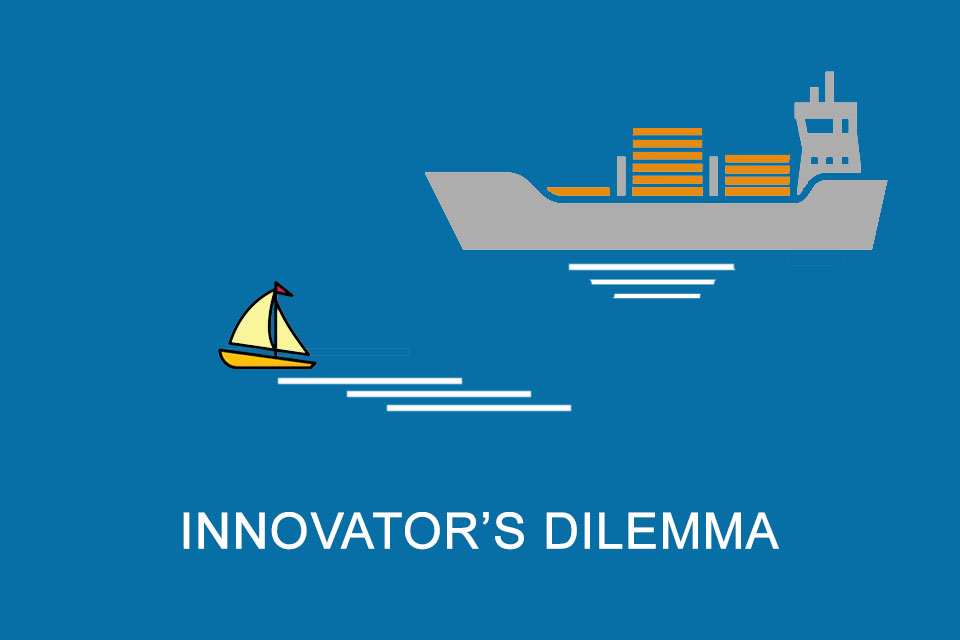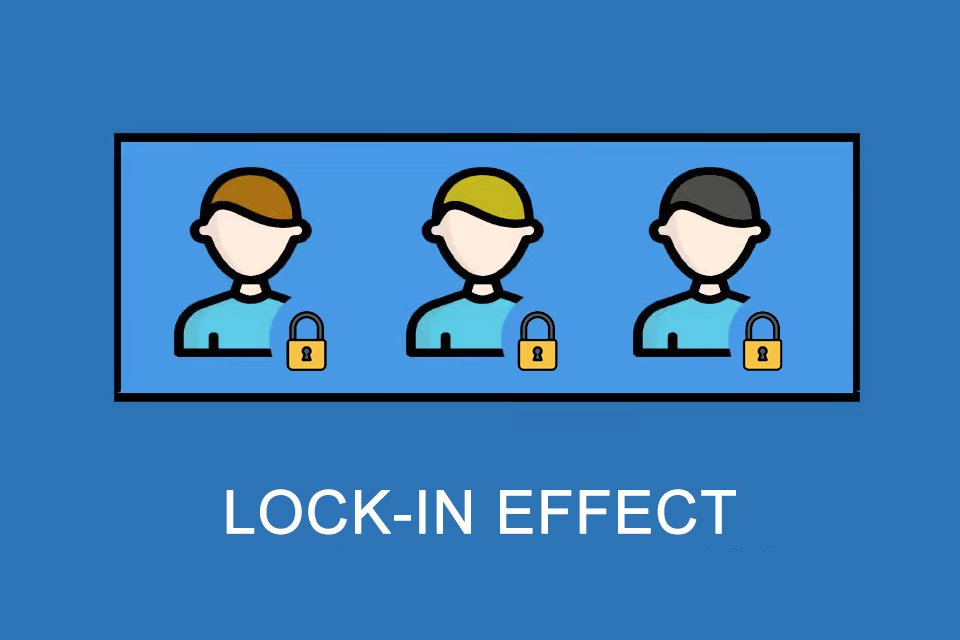What is the Innovator’s Dilemma?
Innovator’s dilemma – when success obscures the future
An established company has been the market leader for years. It knows its customers well, reliably delivers high quality and consistently invests in the further development of its products. Decisions are made based on data, resources are used efficiently – everything is actually going well. And yet at some point it starts to falter. New competitors emerge, offering seemingly simple, initially inferior alternatives, and gain market share. The established company reacts too late or not at all and loses its advantage.
This paradoxical problem has a name: the innovator’s dilemma. It describes the situation in which successful companies ignore or underestimate new, disruptive technologies because they initially do not meet the demands of their most profitable customers.
The term was coined by US economist Clayton M. Christensen in his 1997 book The Innovator’s Dilemma. [1] The dilemma is that focusing on short-term profitability and existing business models makes companies blind to groundbreaking developments, with the result that they are displaced by more flexible, often smaller competitors.
Reasons for the innovators‘ dilemma
The innovators’ dilemma often affects precisely those companies that are particularly successful economically. Why? Because they are doing exactly what seems right from a business perspective: they are listening to their best customers, making targeted investments in existing products, optimising processes and focusing on what generates the most profit. Disruptive innovations, on the other hand, are usually not very mature at the beginning, serve niche markets and initially do not promise high margins, which is exactly the opposite of what established companies align their business model with.
A second reason: disruptive innovations often change not only products, but the entire market. They follow different rules, appeal to new target groups or create completely new usage situations. Sometimes companies recognise that the market is shifting, but they cannot find a strategically sensible or brand-compliant way to participate in it.
An example: a Swiss manufacturer is the market leader in high-priced mechanical watches. Then a US tech company comes along and establishes a completely new product segment with a computer on the wrist. The market shifts in a direction in which the traditional watchmaker does not feel at home. The new market does not fit with the identity, technology and value proposition of the traditional company, and it is precisely in such cases that the full force of the innovators‘ dilemma becomes apparent.
Lessons and tips from the innovators’ dilemma
The innovators’ dilemma is more than just a management problem. It reflects how organisations think, decide and understand themselves. It forces companies to deal with uncomfortable questions: Do we really want change or just growth? Do we have the courage to question things that have made us successful so far?
Here are four key lessons from the innovator’s dilemma and concrete impulses for how companies can arm themselves against its most dangerous effects:
Lesson 1: Success is inert, but innovation needs irritation
Successful companies are geared for efficiency. They reward what works. But that’s exactly what makes them inert to radical new ideas. Innovations that do not immediately fit into existing metrics are considered too risky or immature and are discarded before they even get a chance.
Tip: deliberately set up disruptive structures: innovation teams with a different budget, different metrics, different freedoms. It is not only space that is crucial, but also protection from the optimisation logic of the core business.
Examples: With its ‘Grow’ innovation platform, Bosch has created an environment in which employees can work on new business models in a start-up-like manner, detached from the structures and routines of the core business. This promotes ideas that would otherwise be lost under the efficiency pressure of large organisations.
At 3M, employees are traditionally allowed to use 15% of their working hours for their own, non-specified ideas. The famous Post-it Notes were created in this way, as a by-product of a failed adhesive. It was not the idea alone that was decisive, but the organisational openness to pursue it, even though it did not initially fit into an existing product.
Lesson 2: Disruption is not a technological challenge, but a structural one
Many companies believe they just have to catch up in terms of technology. But it goes much deeper than that: disruptive innovations often require a completely different business model, different price points, different target groups, and this can be incompatible with the existing organisation.
Tip: Instead of keeping everything under one roof, think about structured separation: the new business should not have to adopt the old rules of the game. An independent unit with its own culture, financing and decision-making logic can develop new business ideas much more freely and, if successful, be integrated back into the company or managed as a spin-off.
Example: The Swiss company Swatch was created in the 1980s as a radical response to the quartz crisis – with a cheap watch, plastic casing and pop culture instead of luxury. The parent company allowed Swatch to operate completely differently internally and ultimately saved the company as a result.
Lesson 3: Not every innovation is made for you, but the risk lies in overlooking the right ones
The real problem is not that companies miss every new development, but that they ignore the one development that threatens their core business. Not every new technology is disruptive, but those that are often attack quietly and unexpectedly.
Tip: Create a systematic early warning system for market changes. Don’t just listen to analyst reports and existing customers, but also to the fringes, start-ups, university dropouts, developer forums and crowdfunding platforms. Not everything will be important, but recognising the right thing early on is invaluable.
One possible approach: set up an internal Future Council that regularly analyses scenarios, evaluates weak signals and engages in dialogue with decision-makers as an antenna for what is not (yet) reflected in the figures.
Lesson 4: Brand identity can become an innovation brake
Strong brands create trust, but they can also become prisoners of their own history. When ‘we are the best at X’ becomes part of the identity, it’s hard to even think about ‘Y’. Innovations that don’t fit the brand seem like breaches of identity and are therefore often rejected, even though they would be strategically important.
Tip: regularly ask ‘What remains of us if our main product disappears?’ This question may seem threatening at first, but it is the key to sustainable brand development. The best companies manage to break down their brand identity to its core benefit, not to the product.
Example: Netflix never defined itself as a DVD rental company, but as an entertainment platform, and was thus able to successfully transition from mail order to streaming and finally to its own productions.
Innovation requires structural courage
The innovators’ dilemma cannot be solved by individual workshops or creative methods. It challenges organisations to question their own structure, culture and logic, not just once, but continuously. Those who take innovation seriously must learn to tolerate disorder, nuances and contradictory developments.
It takes courage to live two contradictory truths at the same time: to efficiently develop what already exists and to radically rethink the new. Those who can do this will not only understand the dilemma, but ideally also survive it.
Impulse to discuss
How does your company deal with ideas that at first glance do not seem to fit in with it?
Notes:
[1] Clayton M. Christensen: Innovator’s Dilemma: When New Technologies Cause Great Firms to Fail
Here you will find a video series on the life and work of Clayton M. Christensen.
And here you will find a blog post by Conny Dethloff about the purpose of a company: Purpose? I got one: To stay alive!
If you like the article or would like to discuss it, please feel free to share it in your network. And if you have any comments, please do not hesitate to send us a message.
Here you can find additional information from our Smartpedia section:



